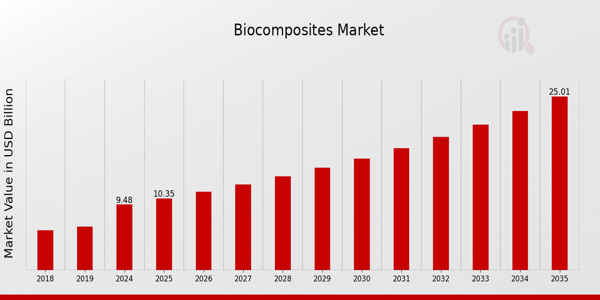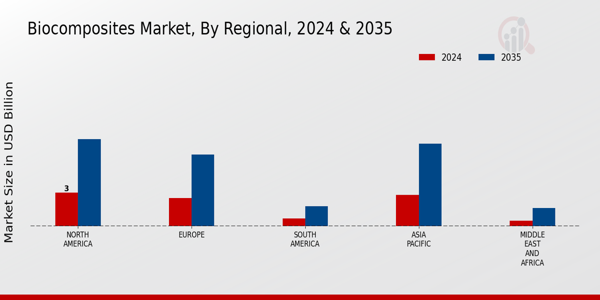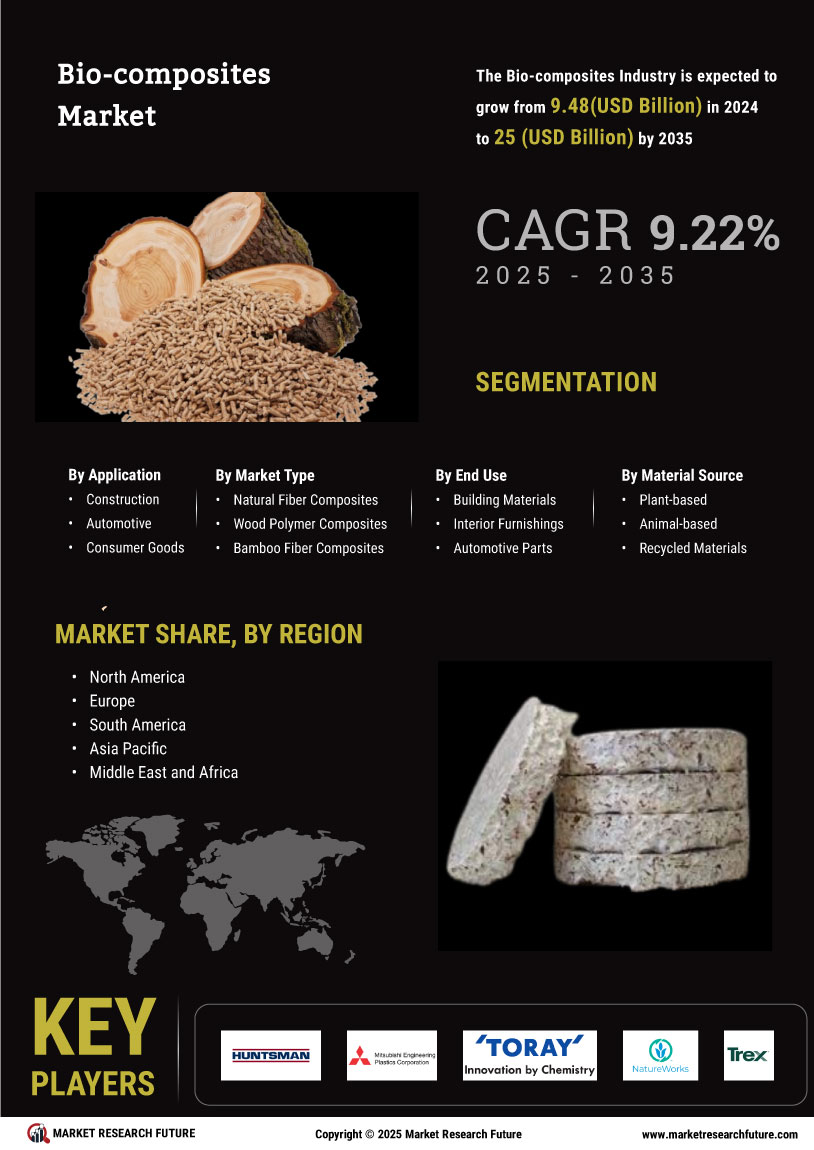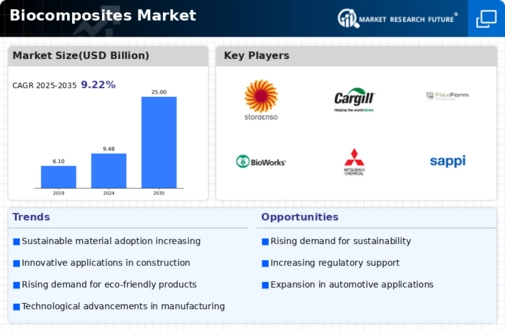
世界のバイオ複合材料市場の概要
MRFRの分析によると、バイオ複合材料市場の規模は2023年に86.8億米ドルと推定されています。バイオ複合材料市場は、2024年の94.8億米ドルから2035年には25億米ドルに成長すると予想されています。バイオ複合材料市場のCAGR(年間成長率)は、予測期間(2025~2035年)中に約9.22%になると予想されています。
注目のバイオ複合材料市場の動向
バイオ複合材料市場は、いくつかの主要な市場推進要因により、大幅な成長を遂げています。持続可能性と環境保護への関心の高まりにより、消費者と業界が従来の材料に代わる環境に優しい代替品を求めているため、バイオ複合材料の需要が高まっています。再生可能資源の使用を促進し、二酸化炭素排出量を削減する政府の取り組みも、この傾向をさらに後押ししています。企業がより環境に優しい製造プロセスを推進するにつれ、自動車、包装、建設などの分野でバイオ複合材料への関心が高まっています。もう一つの重要な側面は、材料特性を向上させ、その応用分野を拡大するバイオ複合材料技術の継続的な進歩です。
注目すべき分野の一つは航空宇宙産業です。航空機の燃費向上には軽量で強度の高い材料が求められるため、バイオ複合材料は有用となる可能性があります。また、環境に優しい製品についてより多くの人々が知るようになるにつれて、特に電子機器や消費財においてバイオ複合材料は改善される可能性があります。市場は、研究機関とメーカーが協力して新しいバイオベース材料を開発することで恩恵を受けることができます。近年、バイオ複合材料の性能向上とコスト削減を目指した研究開発活動が増加しています。循環型経済モデルの普及に伴い、産業界は材料の調達方法や廃棄物処理方法を変えつつあります。これはバイオ複合材料にとって最適な分野です。
さらに、市場関係者は、多様な消費者ニーズに対応するために、生分解性部品の統合をますます重視しています。全体として、バイオ複合材料市場は、環境、技術、および消費者要因によって変革の道を歩んでいます。

出典:一次調査、二次調査、MRFRデータベース、アナリストレビュー
バイオ複合材料市場の推進要因
持続可能な材料に対する需要の高まり
バイオ複合材料市場は、持続可能で環境に優しい材料に対する消費者の需要の高まりにより、大幅な成長を遂げています。欧州バイオプラスチック協会のレポートによると、バイオプラスチックの生産能力は2026年までに2倍になると予想されており、堅調な需要傾向を示しています。いくつかの国では、炭素排出量とプラスチックの使用に関してより厳しい規制を実施しており、メーカーは実行可能な代替品としてバイオ複合材料を模索しています。
国連環境計画などの組織は、持続可能な材料の使用を提唱しており、この傾向をさらに後押ししています。さらに、持続可能な開発目標の達成に向けた推進により、メーカーはバイオ複合材料の研究開発に投資するようになり、バイオ複合材料市場の成長を大幅に促進すると予想されています。
材料処理における技術革新
材料処理技術の進歩は、バイオ複合材料市場の重要な推進力として浮上しています。強化された繊維処理方法や新しい結合技術などの革新により、バイオ複合材料の性能特性が向上し、より幅広い用途でより魅力的なものになっています。例えば、産業パートナーシップから収集されたデータによると、特許取得済みの複合製造プロセスの採用により、バイオベース材料の耐久性と機械的特性が 30% 向上することが示されています。
製造分野の大手企業は、バイオ複合材料の生産効率を向上させるためにますます協力しており、市場の拡大を効果的に推進しています。
環境問題への意識の高まり
環境問題に関する意識の高まりとプラスチック廃棄物の削減は、バイオ複合材料市場の推進要因です。世界経済フォーラムのレポートによると、毎年約 3 億トンのプラスチックが製造され、その多くが海洋に流れ込むため、バイオ複合材料への移行が促進されています。政府はこの課題を認識しており、プラスチック汚染の実行可能な解決策としてバイオ複合材料の使用を積極的に推進しています。
例えば、カナダやドイツなどの国は、バイオ複合材料の採用を奨励する規制を実施することにより、使い捨てプラスチックを削減する取り組みを主導しています。持続可能性に関する国民の意識の高まりは、この市場の将来の成長を支えそうです。
バイオコンポジット市場セグメントの洞察
バイオコンポジット市場のアプリケーションの洞察
バイオコンポジット市場は、特にアプリケーションセグメントにおいて、さまざまな業界で持続可能で環境に優しい材料に対する需要の高まりを反映して、大幅な成長を遂げています。2024年までに、市場は94億8000万米ドルに達すると評価され、建設、自動車、消費財、電子機器、ヘルスケアなどの特定のアプリケーションで予測される成長が顕著に示され、バイオコンポジット全体におけるそれらの重要性が強調されています。建設部門は最大規模で、2024年には21億米ドルと評価され、2035年までに55億米ドルに達すると予想されています。これは、業界が環境への影響を減らすために、より持続可能な建築資材を求めているため、大幅な増加を示しています。
建設におけるこの採用の傾向は、政府の規制とグリーンビルディングの実践への重点の増加によって推進されており、バイオ複合材料市場の収益における主要なプレーヤーとなっています。同様に、自動車部門は2024年に22億米ドルと評価され、2035年までに60億米ドルに拡大すると予測されています。自動車用途におけるバイオ複合材料の重要性は、燃費向上と車両重量軽減の可能性にあり、現在の気候に配慮した市場では極めて重要な炭素排出量の削減にも貢献します。
消費財はもう1つの重要な分野であり、市場価値は2024年に23億米ドル、2035年までに65億米ドルに上昇すると予測されています。日常的な製品におけるバイオ複合材料への移行は、持続可能な選択肢に対する消費者の選好によって推進されており、この用途の重要性を高めています。エレクトロニクスは、2024年に14億米ドルの評価額が2035年までに40億米ドルに達すると予測されており、ニッチな用途を見出し、電子廃棄物の削減に不可欠な生分解性部品の開発に力を入れています。最後に、ヘルスケア部門は規模は小さいものの、2024年には14億8000万米ドルと評価され、30億米ドルまで成長すると予想されており、医療機器、足場、薬物送達システムにおけるバイオ複合材料の適用性を示し、環境に優しく患者の転帰を向上させる上でのバイオ複合材料の重要性を強調しています。
全体として、バイオ複合材料市場のセグメンテーションは、持続可能性の目標との強力な整合性を示しており、これらの極めて重要なアプリケーション全体で成長と革新の多くの機会を提供しています。これらの分野で再生可能で持続可能な材料の使用にますます重点が置かれていることは、現代の環境問題に対処しながら市場が力強く拡大する可能性を示しています。

出典:一次調査、二次調査、MRFRデータベース、アナリストレビュー
バイオコンポジット市場タイプ洞察
バイオコンポジット市場は、利用可能なさまざまな種類のバイオコンポジットによって牽引され、著しい成長を遂げています。これらのうち、天然繊維複合材料、木材ポリマー複合材料、竹繊維複合材料、麻繊維複合材料は、さまざまな用途で重要な役割を果たしています。市場全体は、2024年までに94億8000万米ドルに達すると予想されており、これは業界全体で持続可能で環境に優しい素材への需要の高まりを反映しています。植物由来の素材を使用する天然繊維複合材は、軽量で高い強度対重量比により、市場の収益に大きく貢献しています。
木材ポリマー複合材は、従来の素材に比べて耐久性と耐湿性に優れているため、建設および自動車分野でますます人気が高まっています。一方、竹繊維複合材は、竹の成長が速いことから注目を集めており、魅力的な再生可能資源となっています。麻繊維複合材は、炭素隔離や製造時のエネルギー消費量削減などの利点があり、環境意識の高い消費者にとって魅力的です。この種類の多様性は、バイオ複合材料市場の細分化を強化するだけでなく、サプライチェーンの制限や処理コストなどの課題に対処しながら、多くの成長機会をもたらします。これらの要因は、持続可能な慣行への重点がますます高まっていることと一致して、市場をさらに推進すると予想されます。
バイオ複合材料市場の最終用途の洞察
バイオ複合材料市場は、特に建築材料、内装家具、自動車部品、包装材料などのさまざまな用途を網羅する最終用途セグメントで大幅な成長を遂げています。2024年までに、市場全体は94億8000万米ドルに達すると予想されており、複数の業界で持続可能な代替品に対する需要を示しています。これらの用途の中で、建築材料と自動車部品は、持続可能性と環境責任に向けたトレンドに沿っているため重要です。
二酸化炭素排出量の削減への重点の高まりにより、建設および自動車部門におけるバイオ複合材料の採用が増加しています。消費者は美しさと持続可能性を兼ね備えた環境に優しい製品を求めており、室内装飾品も重要な分野です。さらに、環境意識の高まりは包装材料を変革し、消費財における生分解性および再生可能な部品の需要を促進しています。バイオコンポジット市場データは、持続可能なソリューションへの移行を示しており、業界がより環境に優しい素材へと方向転換するにつれて、イノベーションと拡大の機会が明らかになり、市場の成長に大きな影響を与えています。
市場はこれらのトレンドと課題を活用し、さまざまな用途にわたって回復力と適応性を促進するのに有利な立場にあります。
バイオコンポジット市場の材料ソースに関する洞察
バイオ複合材料市場は、特に材料源の観点から、持続可能な慣行と環境に優しい材料によって顕著な変革を経験しています。2024年までに市場規模は94億8000万米ドルに達すると予測されており、さまざまな業界でバイオ複合材料の採用が拡大することが強調されています。この分野では、植物由来の材料は再生可能で環境への影響が少ないことから勢いを増しており、市場成長の重要な原動力となっています。廃棄物の削減に取り組み、持続可能性を促進するため、リサイクル材料も目立つ存在となっています。
一方、動物由来の資源は、製品のパフォーマンスを向上させる独自の特性を提供する上で重要な役割を果たしていますが、全体の使用量に占める割合は小さいです。企業が持続可能なソリューションを優先するにつれて、バイオ複合材料市場のセグメンテーションは、消費者の需要と規制要件の両方を満たすために不可欠な、責任ある調達慣行への明確な傾向を反映しています。これらの傾向は、これらの材料源の潜在能力を最大限に活用し、将来の市場機会を獲得するために、研究開発への継続的な革新と投資の必要性を強調しています。
バイオ複合材料市場の地域別洞察
バイオ複合材料市場は地域によって大きく分かれており、北米の市場評価額は2024年に30億米ドルに達し、2035年までに78億米ドルに達すると予測されています。この地域は製造業における持続可能性への大きなトレンドを示しており、市場の成長に重要な役割を果たしています。ヨーロッパはこれに続き、2024年には25億米ドルの評価額となり、厳しい環境規制により環境に優しい材料の需要が高まるため、64億米ドルに成長すると予測されています。アジア太平洋地域は、2024年には28億米ドルと推定されていますが、工業化の進展と持続可能な製品に対する消費者意識の高まりを背景に、急速に拡大し、74億米ドルに達すると予想されています。
南米は、2024年の7億米ドルと比べると規模は小さいものの、豊富な天然資源と新興市場を背景に18億米ドルまで成長すると予測されており、潜在力を示しています。最後に、中東およびアフリカは4億8千万米ドルと推定されており、これらの地域における再生可能素材への投資の増加を反映し、16億米ドルに達すると予想されています。各地域には独自の機会と課題があり、地元の政策や市場の動向がバイオコンポジット市場におけるそれぞれの地位に大きく影響を及ぼしています。

出典:一次調査、二次調査、MRFRデータベース、アナリストレビュー
バイオコンポジット市場の主要プレーヤーと競合分析
バイオコンポジット市場は、企業や消費者が従来の素材に代わる環境に優しい代替品を求めているため、ますます注目を集めています。この市場には、耐久性の向上、軽量化、環境への影響の低減などの強化された特性を備えた再生可能資源から作られた幅広い製品が含まれています。新興技術と変化する消費者の嗜好により、バイオ複合材料に大きな革新がもたらされ、この分野の主要プレーヤー間の競争が激化しています。競争環境はさまざまな戦略を特徴としており、企業は製品開発、戦略的パートナーシップ、持続可能性への取り組みの進歩を通じて市場シェアを競っています。持続可能な素材の需要が高まるにつれて、自動車、建設、消費財など、多様な業界に対応するために、企業はリーチを拡大し、ブランドの存在感を強化することにも注力しています。
Trex Companyはバイオコンポジット市場の主要プレーヤーであり、主に環境に配慮した高性能の木材代替デッキ製品の製造で知られています。同社は独自のリサイクル素材の配合を活用し、色あせ、汚れ、カビに強い製品を提供しており、メンテナンスの手間が少なく環境に優しいソリューションを求める消費者にますます好評です。持続可能性に重点を置いているTrex Companyは、強力なブランド評判を築き上げ、市場での競争優位性を維持しています。研究開発に継続的に投資することで、Trexは製品ラインを革新し、拡大し、品質と顧客満足度の強みを示すことができます。同社は環境に配慮した製造プロセスに注力しており、急速に進化する市場における地位をさらに強化しています。
Trestle Holdingsは、さまざまな用途向けに設計された革新的なバイオ複合材料を含む多様なポートフォリオを通じて、バイオ複合材料市場での存在感を確立しています。同社は、機能性と持続可能性を兼ね備えた製品の開発に力を入れており、建設や包装などの分野に対応しています。Trestle Holdingsは、強力な市場プレゼンスと環境に配慮した取り組みで知られており、幅広い顧客基盤にアピールしています。同社の強みは、市場のニーズに基づいてソリューションをカスタマイズできることであり、これは機能の強化と製品ラインナップの拡大を目的とした戦略的な合併や買収によって支えられています。同社は、この急成長産業における競争力維持のため、サプライチェーンの強化と業務効率化の機会を積極的に模索しています。
バイオコンポジット市場の主要企業
- Trex Company
- Trestle Holdings
- Stora Enso
- Cargill
- Green Fiber
- FlexForm Technologies
- Bioworks
- 三菱ケミカル
- Sappi
- Natureworks
- BASF
- Hexcel
- Metsa Group
- Dow
- DuPont
バイオコンポジット市場の動向
バイオコンポジット市場の最近の動向バイオ複合材料市場は、多額の投資と技術の進歩によって形成されてきました。Trex CompanyやTrestle Holdingsなどの企業は、持続可能な製品に対する消費者の需要の増加に起因する成長を報告しています。2023年10月、Stora Ensoは包装業界向けの新しいバイオ複合材料ラインを立ち上げ、イノベーションへの取り組みを強化しました。カーギルは、生分解性ソリューションに重点を置いており、プラスチックをより持続可能な選択肢に置き換えることを目指しています。さらに、Hexcelはバイオ複合材料強化材でポートフォリオを拡大し、航空宇宙用途における環境に優しい材料の推進を強調しています。
合併と買収の面では、2023年9月にデュポンがFlexForm Technologiesの買収を発表し、バイオ複合材料の能力を強化しました。BASFやNatureworksなどの企業が自動車や建設などの特定の業界に対応するために製品ラインを進化させ続けているため、市場評価の成長は明らかです。ここ数年、研究開発に重点を置いた共同プロジェクトの増加など、重要なトレンドも現れており、バイオコンポジット市場の企業は、持続可能な慣行への高まる圧力に適応できるようになりました。
バイオコンポジット市場のセグメンテーションに関する洞察
バイオコンポジット市場の用途展望
- 建設
- 自動車
- 消費財
- エレクトロニクス
- ヘルスケア
バイオコンポジット市場のタイプ別展望
- 天然繊維複合材
- 木材ポリマー複合材
- 竹繊維複合材
- 麻繊維複合材料
バイオコンポジット市場の最終用途展望
- 建築材料
- 内装材
- 自動車部品
- 包装材
バイオコンポジット市場の原料供給源展望
- 植物由来
- 動物由来
- リサイクル材料
バイオコンポジット市場の地域別展望
- 北米
- ヨーロッパ
- 南米
- アジア太平洋地域
- 中東・アフリカ
FAQs
What is the current valuation of the Biocomposites Market as of 2024?
The Biocomposites Market was valued at 35.83 USD Billion in 2024.
What is the projected market valuation for the Biocomposites Market in 2035?
The market is projected to reach a valuation of 185.48 USD Billion by 2035.
What is the expected CAGR for the Biocomposites Market during the forecast period 2025 - 2035?
The expected CAGR for the Biocomposites Market during the forecast period 2025 - 2035 is 16.12%.
Which application segment is expected to show the highest growth in the Biocomposites Market?
The Automotive application segment is projected to grow from 10.0 to 50.0 USD Billion.
What are the key types of biocomposites currently dominating the market?
Natural Fiber Composites and Wood Polymer Composites are key types, with valuations ranging from 10.0 to 50.0 USD Billion and 12.0 to 60.0 USD Billion, respectively.
Which companies are considered key players in the Biocomposites Market?
Key players include BASF SE, Trex Company, Inc., and Mitsubishi Chemical Corporation, among others.
What end-use segment is anticipated to have a significant market share in 2035?
The Packaging Materials end-use segment is expected to grow from 10.83 to 60.48 USD Billion.
How does the market for plant-based materials compare to animal-based materials in the Biocomposites Market?
The market for plant-based materials is projected to range from 15.0 to 75.0 USD Billion, while animal-based materials range from 10.0 to 50.0 USD Billion.
What is the expected growth trajectory for the Healthcare application segment in the Biocomposites Market?
The Healthcare application segment is anticipated to grow from 5.83 to 35.48 USD Billion.
このレポートの無料サンプルを受け取るには、以下のフォームにご記入ください
Customer Stories

“This is really good guys. Excellent work on a tight deadline. I will continue to use you going forward and recommend you to others. Nice job”

“Thanks. It’s been a pleasure working with you, please use me as reference with any other Intel employees.”

“Thanks for sending the report it gives us a good global view of the Betaïne market.”

“Thank you, this will be very helpful for OQS.”

“We found the report very insightful! we found your research firm very helpful. I'm sending this email to secure our future business.”

“I am very pleased with how market segments have been defined in a relevant way for my purposes (such as "Portable Freezers & refrigerators" and "last-mile"). In general the report is well structured. Thanks very much for your efforts.”

“I have been reading the first document or the study, ,the Global HVAC and FP market report 2021 till 2026. Must say, good info! I have not gone in depth at all parts, but got a good indication of the data inside!”

“We got the report in time, we really thank you for your support in this process. I also thank to all of your team as they did a great job.”


コメントを残す